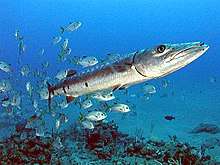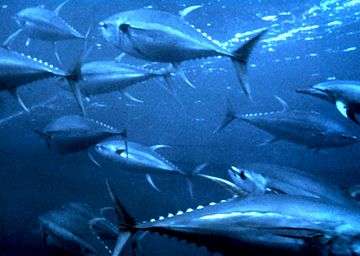Aquaculture Stewardship Council
The Aquaculture Stewardship Council (ASC) is an independent non-profit organisation and labelling organization that establishes protocol on farmed seafood while ensuring sustainable aquaculture. The ASC provides sustainable and responsible aquaculture producers with a stringent certification and labelling scheme guaranteeing to consumers that the seafood they are purchasing is sustainable for the environment, and socially responsible. The Aquaculture Stewardship Council was founded in 2010 by the World Wide Fund for Nature (WWF) and the Dutch Sustainable Trade Initiative (IDH).[1] According to their website, the ASC's Vision is "[a] world where aquaculture plays a major role in supplying food and social benefits for mankind whilst minimizing negative impacts on the environment".[2] Their mission is "[to] transform aquaculture towards environmental sustainability and social responsibility using efficient market mechanisms that create value across the chain.".[3] The ASC is an example of multistakeholder governance, and a full member of the ISEAL Alliance, a sustainability standards setting membership.
Personnel
The current ASC CEO is Chris Ninnes [4]. In February 2016, Aldin Hilbrands, Meghan Jeans, Scott Nichols, and Ling Cao joined the ASC Supervisory Board.[5]
Accreditation Process
The standards of the ASC have resulted from the WWF-initiated Aquaculture Dialogues, a multi-stakeholder series of dialogues held over the course of a decade and which involved around 2,000 scientists, NGOs, industry participants and other interested parties (farmers, processors, retailers and government agencies). In order for an aquatic farm to be certified by the ASC, a comprehensive series of criteria must be fulfilled; including pre-assessment, on-site farm audit and an audit report. All the audit reports for all the ASC-certified farms are transparently made available to the public via the ASC's website.
The ASC has standards for the 12 following species: abalone, bivalves (clams, mussels, oysters and scallops), freshwater trout, pangasius, salmon, seriola and cobia, shrimp, and tilapia.[6] A Feed Standard is currently being elaborated; whilst standards for several other species are under consideration (notably sea bass and sea bream). New standards must follow a transparent setting procedures, involving several rounds of public consultation; with all feedback made public. An Indonesian tilapia farm was the first to have reached ASC-certification in 2012.
Several pre-competitive organizations are now using the rigorous ASC standards as a means to progress their industry towards more environmental sustainability and social responsibility: such as the Global Salmon Initiative (GSI, established in 2013); and the Sustainable Shrimp Partnership (SSP, launched in March 2018[7]) which operates in Ecuador.[8] The GSI member companies (representing over 50% of the world's global farmed salmon production) have pledge to have all their salmon farms ASC-certified by 2020.[9]
Certification
The ASC covers certifies different species groups which includes Tilapia, Salmon, Pangasius, Bivalves, Cobia and Shrimp. In November 2017, a Seaweed Standard was also launched by the ASC together with the Marine Stewardship Council (MSC). Certified ASC products are now available around the world in Austria, Belgium, Canada, Czech Republic, Denmark, Finland, France, Germany, Italy, Hungary, Luxembourg, Netherlands, Norway, Slovenia, Spain, Sweden, Switzerland and the United Kingdom [10].
In May 2018, the ASC-certified volume had reached 1.4 million tonnes (including close to 750,000t of salmon, 202,000t of pangasius, 156,000t of tilapia, 141,000t of bivalves, 113,000t of shrimp). There are over 100 bivalve farms ASC-certified, 250 salmon farms... 621 farms in total as of May 2018 (209 in Europe, 170 in Asia, 147 in South America, 71 in North America, 21 in Oceania, and 3 in Africa), with over 200 currently in assessment...
Notes and references
- About the Aquaculture Stewardship Council, www.asc-aqua.org (page visited on 14 November 2015).
- "About the ASC".
- "About the ASC".
- "Chris Ninnes".
- "ASC Appoints Four New Members to Supervisory Board".
- https://www.asc-aqua.org/what-we-do/our-standards/farm-standards/
- "Home". Sustainable Shrimp Partnership. Retrieved 20 April 2020.
- White, Cliff. "With an eye on India, Ecuador launches Sustainable Shrimp Partnership". Seafood Source. Retrieved 13 March 2018.
- "ASC certification". Global Salmon Initiative. Retrieved 20 April 2020.
- https://mailchi.mp/asc-aqua/xr162vrjvq-2118633?e=9ebd51a70d
External links
- Official website: www.asc-aqua.org

